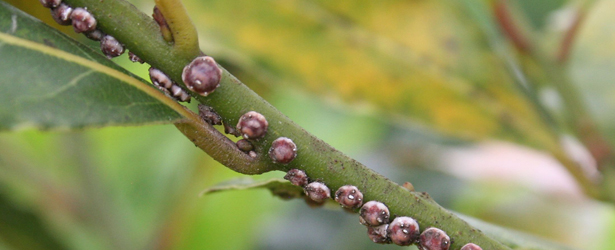HOW MILLIONS OF TINY INSECTS COLORED GLOBAL TRADE
When wealthy Dutch burghers sat down to sumptuous feasts, they took great pride in the sophisticated and lavish decorations that appointed their dining rooms. They were particularly fond of the exquisite Flemish tapestries that covered their walls. Crafted from wool or silk, bordered by silver and dyed with brilliant scarlets and crimsons, these wall hangings declared not only their owners’ wealth, but their worldliness: they were a creation of world trade. But for two centuries few Europeans knew how these lovely creations were bathed in color. Yes, they knew that Hernán Cortez had sent the mysterious cochineal dye back to Spain after the conquest of Mexico. But they were not exactly sure what it was made from. They assumed that it was a seed like many other vegetable dyes. Not until the end of the 17th century did Italian chemists discover that the cochineal seeds were not seeds at all; they were the dried bodies of insects. The stately, elegant tapestries were smeared with dead bugs!
Of course Indians in southern Mexico and Central America had long known this. The Aztecs had already demanded cochineal as a tribute good from the southern regions of Chiapas and Oaxaca. But Enlightenment Europeans could not imagine asking Indians about a matter of natural science. So they remained ignorant for a couple of hundred years. The superior knowledge of the Mixtec and Mayan Indian producers meant that they would continue to dominate production for centuries.
Most Mixtecs knew that cochineal was made from the female cochineal insect (Dactylopius coccus), which fed on a particular nopal cactus that inhabited a limited range. In the wild, Indians would pluck them off the cactus and plunge them in hot water or into an oven. This was a precise, laborious business since it took some 70,000 dead bugs to make one pound of cochineal. Only the female insect would do, but since she outnumbered the males by 150-200 to 1 (talk about a man-hungry world!) this was not a great problem. However, mature virgin bugs, which were more prevalent early in the season, gave off stronger colors. So timing was important.
Wandering the countryside hunting for female bugs was a time-consuming business for Indians who had children and other crops to tend to. Thus a more intense form of “cultivation” was developed. “Seed” pregnant cochineal were placed in bags made of maize leaves and pinned to cactus leaves. Shortly, the insects began to breed and the young crawled out onto the cactus. After roughly three months—depending on the weather—they were ready for harvesting. In good climates three crops a year were possible. After about five years new nopals had to be found or planted since by that time the guests had eaten the host. This practice was termed agriculture with “seed” and “harvests.” But it really was livestock raising. (Instead of a flea circus, one had a herd of bugs.)
The tiny scale of the livestock, however, meant that the social implications were quite different from cattle raising. Whereas grazing bovines usually caused land to be concentrated in the hands of Europeans who expelled Indians and left the pastures sparsely inhabited, a herd of cochineals, as one would imagine, required very little space. Consequently, they did not much affect other activities or living arrangements. Indeed, the nopal were usually interspersed between subsistence crops such as maize and beans. Often they occupied the house plots. In Guatemala’s former capital of Antigua, destroyed by a volcano, cochineal were raised in the ruins of what used to be elegant houses and stables.
Indian communities were not harmed and, indeed, were sometimes strengthened by cochineal. There were no economies of scale. Small plots tended to produce better quality dye than larger ones where labor and supervision were lacking. Moreover, this was a very risky trade that required considerable expertise. Only the proper cactus and climate yielded cochineal. Even then, unseasonal heavy rains or locusts could slaughter the little bugs. The unglamorous, backbreaking, neck-craning work of “cultivation” meant that few Spaniards ever attempted to ferret out the Indian trade secrets. Instead, they allowed the Indians to maintain their domination of this pre-Columbian crop.
For most of the boom period of cochineal, the colonial Spanish state was responsible for collecting the insects as tribute. In the late colonial period, to expand production, the reparto de mercancías was sometimes employed. This was the forced sale of goods by government officials and sometimes churchmen to Indians who were required to purchase the often-unwanted goods with cochineal. In effect, the bugs could not only be sold for money; they served as money themselves.
When state coercion officially ended after independence, in few places did Indians lose control of the “industry.” Indians usually rented communal land to grow the cactus so much of the income went to village coffers for collective celebrations and public buildings. Only in a few places did Europeanized Ladinos appropriate the land and dominate production.
In virtually every other case in Latin America the increased export of indigenous crops such as cacao, rubber and henequen led to subjugation and impoverishment of Indians. They were only able to keep their grip on cochineal bugs because of the precarious and labor-intensive nature of the enterprise and special-expertise harvesting required.
The result was that many of the finest drapes, silks and tapestries of Europe depended upon the Indians of Mexico, Guatemala and later Peru for their eye-catching crimsons and scarlets. The jackets that the famed British “redcoats” wore on their backs were colored with the bug dye as were the scarlet letters real-life Hester Prynnes wore on their breasts.
For four centuries the world economy could not crack the Indian monopoly on cochineal. After the 1850s German and British chemists substituted for it by inventing aniline dyes. Although initially not as brilliant and colorfast as natural dyes, they were cheaper and could be produced in the great amounts that the cotton textile revolution was demanding. Sterile factories replaced the gathering of insects. The heroic cochineal bug, which sacrificed her brilliant body to palpably introduce the cactus-strewn countryside of the New World into the wealthy dining halls of Amsterdam and other major European cities, disappeared from the world economy. The new industrial dyes became just as colorful as cochineal, but alas their stories were not.





Leave a Reply